Saturday, February 29, 2020
Travelore Report, Monthly In Print Since 1971: 2020 PHS Philadelphia Flower Show To Take Visitors...
Travelore Report, Monthly In Print Since 1971: 2020 PHS Philadelphia Flower Show To Take Visitors...: The 2020 PHS Philadelphia Flower Show, “Riviera Holiday,” will bring designers and visitors to the Mediterranean Riviera from Februa...
Does Travel Insurance Cover Coronavirus, What You Need To Know.
On January 21, 2020, the Coronavirus disease 2019 (COVID-19) became a named event, which affects the travel insurance coverage available for new policies purchased.
For those purchasing travel insurance AFTER 1/21/2020 (exceptions may apply if traveling to a country with a Travel Health Notice issued by the CDC) benefits included in comprehensive coverage may apply in the following unforeseen scenarios:
- Emergency Medical Coverage: a sick traveler must see a doctor and/or go to the hospital during a trip.
- Emergency Medical Evacuation Coverage: in rare cases, a sick traveler requires an emergency medical evacuation to the nearest appropriate hospital or back home for recuperation.
- Trip Interruption: an extremely sick traveler cannot continue with a trip and must return home.
- Cancel for Any Reason: Currently, if you are looking for trip cancellation coverage because you are concerned about the coronavirus, you will now need to purchase a plan that includes Cancel For Any Reason since the travel warnings are now foreseen. This benefit is time-sensitive and has other eligibility requirements, so not all travelers will qualify.
Some plans may exclude epidemics/pandemics and may not provide coverage for related issues. Please be sure to read the plan details carefully before purchasing.
Remember that travel insurance helps to cover unexpected events. Similar to a weather event, once an event becomes a "known" event, it may not be a covered reason for cancellation if a traveler purchases insurance after that date.
For travelers who purchased a policy BEFORE 1/21/20 and need to make a claim or have questions about how your existing policy will cover you, please reach out to your insurance provider. Travelers can read further on how to file a travel insurance claim here.
Should you have any questions, please don’t hesitate to call us for help. Our Customer Care representatives can be reached by dialing toll-free at 800-487-4722 Monday - Friday 7:00am to 12:00am EST and Saturday - Sunday 9:00am to 9:00pm EST.
Which Countries are Affected by the Coronavirus Outbreak?
There are confirmed cases of the coronavirus reported all across the world. The virus originated in the Chinese city of Wuhan. On January 30, 2020, the World Health Organization (WHO) declared the Coronavirus disease 2019 (COVID-19) a global health emergency. Because of this, many countries have begun implementing strict screening procedures in order to prevent the spread of the virus. In the United States, the Department of State’s Travel Advisory for China is currently a Level 4- Do Not Travel to China. A Presidential Proclamation went into effect on February 2, 2020, barring entry to the U.S. of most foreign nationals who traveled to China within the past 14 days. U.S. citizens traveling by cruise ship to or within Asia are being asked to reconsider their travel plans. U.S. citizens planning travel by cruise ship elsewhere should be aware that this is a dynamic situation and they may be impacted by travel restrictions affecting their itineraries or ability to disembark, or may be subject to quarantine procedures implemented by the local authorities. Travel Health Notices have also been issued by the CDC for Italy, Iran, Japan, and South Korea.
How is Coronavirus Spread?
How the coronavirus disease 2019 (COVID-19) spreads is currently unconfirmed. Based on knowledge about similar coronaviruses, it is believed that this coronavirus is spread mainly from person to person. The virus (SARS-CoV-2) becomes airborne when an infected person coughs or sneezes, and can travel up to six feet. It is also believed that the virus can be spread through contact with infected surfaces or objects. A person can get the disease (COVID-19) by touching a surface or object that has the virus on it and then touching their own mouth, nose, or eyes. This information is changing as more is learned about the virus so travelers are encouraged to check the CDC website for the most up-to-date information.
Why is Coronavirus Dangerous?
The coronavirus, sometimes written as "corona virus," is a highly contagious, pneumonia-causing illness that infects the respiratory system. Symptoms can include a fever and cough that may progress to a severe pneumonia, which causes shortness of breath and difficulties breathing. Symptoms of this disease may appear in as few as 2 days or as long as 14 days after exposure. The situation is evolving as more information becomes available. For the latest information, refer to the U.S. Center for Disease Control and Prevention (CDC).
Is There a Coronavirus Vaccine for Humans?
There are currently no vaccines available. Being proactive is the best method of prevention - wash your hands often with soap and water for at least 20 seconds, avoid touching your eyes, nose, or mouth with unwashed hands, and avoid close contact with people who are sick. If you are sick, prevent the spread of illness by staying home, avoiding contact with others, cleaning surfaces and objects with disinfectant, and covering your mouth when you cough or sneeze. Refer to the U.S. Center for Disease Control and Prevention (CDC) for the latest information on prevention.
Coronavirus & Cruises - Common Traveler Questions
If I get sick and quarantined on a cruise ship, does travel insurance cover me?
Possibly. Companies have different requirements for what is considered "quarantined", so it is important to read your policy or call to clarify coverage.
If I'm not sick and quarantined on a cruise ship, does travel insurance cover me?
Possibly. Like cruisers who get sick and are quarantined, those who are not sick but are still quarantined are subject to the same guidelines as defined by the provider and policy.
If I get sick with coronavirus on a cruise ship, will travel insurance help evacuate me?
It is extremely rare for travel assistance companies to arrange for evacuation off of a cruise ship. Typically, you have to be hospitalized first and the assistance company will work with the attending physician to arrange transportation to another hospital, or back home if required.
If I get sick with coronavirus on a cruise ship, who pays my medical bills?
If a traveler gets sick on a cruise ship and requires medical care, he or she may be able to file a claim with their travel insurance company to request reimbursement. It is important to keep all receipts and detailed documentation related to medical care received while on your trip.
If my cruise line cancels a cruise due to coronavirus, does travel insurance cover me?
Cancel For Any Reason selected, they may be able to be refunded a portion (typically 50-75%) of their insured pre-paid non-refundable trip cost if the cruise line cancels the cruise prior to departure and they decide to cancel their entire trip. Cancel For Any Reason is a time-sensitive benefit with some eligibility requirements, and you must cancel at least 2 days prior to departure.
What if I'm afraid to go on an upcoming cruise due to coronavirus?
Coverage is very limited, as typical travel insurance policies don't cover fear of travel. If the traveler has purchased a plan with optional Cancel For Any Reason selected, they may be able to be refunded a portion (typically 50-75%) of their insured pre-paid non-refundable trip cost if there is fear of traveling due to coronavirus prior to departure. Cancel For Any Reason is a time-sensitive benefit with some eligibility requirements, and you must cancel at least 2 days prior to departure.
Additional Travel Advice for Coronavirus
Stay informed of the latest information on the Novel Coronavirus by referring to:
Disclaimer: The information contained in this article serves as a general overview of benefits and should only be used for informational purposes. Refer to your individual certificate of insurance for specific coverages, exclusions, and benefits. When in doubt, please contact one of our licensed agents for additional assistance.
Source: https://www.insuremytrip.com/
Thursday, February 27, 2020
Virgin Galactic Reports High Interest In Its Space Flights
LOS ANGELES (AP) — Virgin Galactic has received nearly 8,000 online reservations of interest since its first successful test flight into space 14 months ago, the company said Tuesday as it nears commercial operation and prepares to reopen ticket sales.
Virgin Galactic already had more than 600 firm reservations that were taken from customers in 60 countries until the December 2018 flight, when it closed down ticket sales.
The company said that on Wednesday it will begin a process called “One Small Step” that will allow those online registrants who are serious about becoming passenger astronauts to register online for a firm reservation by paying a fully refundable deposit of $1,000.
Confirming a spaceflight reservation will be a process called ”One Giant Leap,” echoing the words of Apollo 11 astronaut Neil Armstrong when he became the first person to set foot on the moon in 1969.
The company did not say when the new set of seats would be released or the actual cost. The initial seats were sold at $250,000 apiece.
After years of development and testing at Mojave Air & Space Port in Mojave, California, Virgin Galactic has been moving toward starting actual operations at Spaceport America in southern New Mexico — although it has not set a date.
A special carrier aircraft recently ferried its spaceship, VSS Unity, from California to New Mexico and said construction of the next two spacecraft is well underway.
Virgin Galactic is offering suborbital flights to an altitude of at least 50 miles (80.5 kilometers), where passengers will see a vast swath of the Earth far below and experience a few minutes of weightlessness before the spacecraft glides to a landing.
The current 7,957 online registrations are more than double the number the number the company last reported in September 2019.
Stephen Attenborough, the company’s commercial director, said in a statement that the increasing demand for personal spaceflight was encouraging.
“One Small Step allows us to help qualify and build confidence in our direct sales pipeline, as well as to ensure that those who are most keen to make reservations, are able to do so at the earliest opportunity,” he said.
Virgin Galactic was founded by British billionaire Richard Branson after the historic 2004 flights of the experimental SpaceShipOne, which was funded by Microsoft co-founder Paul Allen and won the $10 million Ansari X Prize as the first privately developed, manned rocket to reach space.
Virgin Galactic’s six-passenger spacecraft is a type called SpaceShipTwo. A carrier aircraft carries it to high altitude and releases it before its rocket engine ignites.
The company is now formally named Virgin Galactic Holdings Inc. and went public on the New York Stock Exchange in October. The fleet is being manufactured by The Spaceship Company, a wholly owned subsidiary.
By JOHN ANTCZAK
Wednesday, February 26, 2020
Dazzling Redesign Of The Allison And Roberto Mignone Halls Of Gems And Minerals At The American Museum Of Natural History Will Open In Fall 2020
| February 25, 2020 |
| _________________________________________________________________________________ |
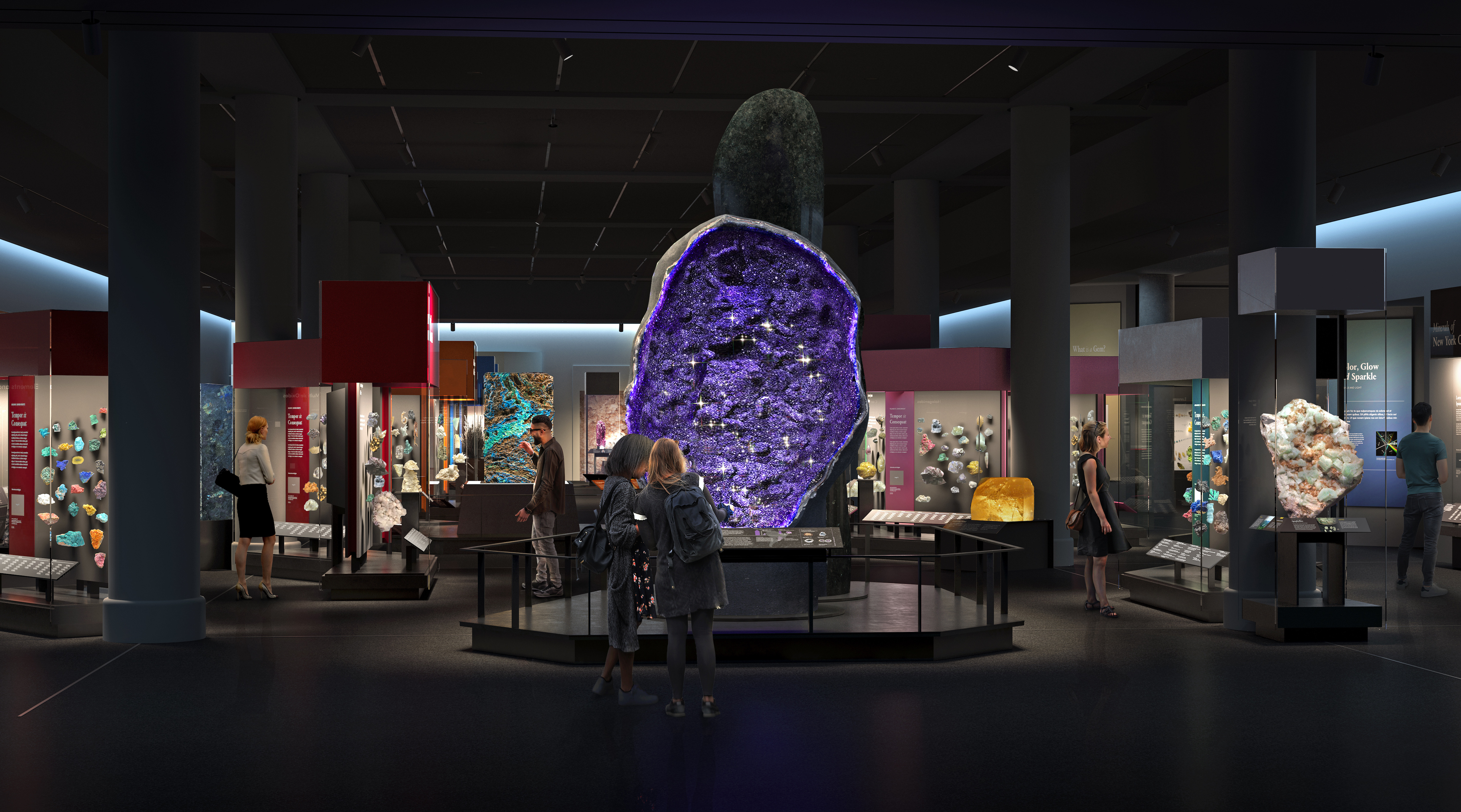
Re-Envisioned Halls Will Present the Current Science of Mineral Formation andShowcase Spectacular New Specimens and World-Renowned CollectionA New Temporary Exhibition Gallery to Open with Beautiful Creatures,
A Celebration of Vintage and Contemporary Jewelry Inspired by Animals
|
The American Museum of Natural History today announced that it will open the completely redesigned Allison and Roberto Mignone Halls of Gems and Minerals in fall 2020. A brilliant showcase for one of the greatest collections of its kind and an engaging guide to recent science about our dynamic planet, the 11,000-square-foot halls will feature:
- recently acquired specimens, including two remarkable amethyst geodes that are among the world’s largest on public display
- a gallery of gems re-presenting treasures such as the legendary 563-carat “Star of India” sapphire and 632-carat Patricia emerald
- and the halls’ first temporary exhibition gallery, opening with Beautiful Creatures, a celebration of exquisite historic and contemporary jewelry inspired by animals.
With interactive displays, touchable specimens, and media, the halls’ redesigned exhibits will tell the fascinating story of how the vast diversity of mineral types—which, similarly to biological organisms, are grouped into species—arose on Earth, how scientists classify them, and how humans have used them throughout the millennia for personal adornment, tools, and technology.
Highlights will include a luminous gallery featuring a wall-sized panel of rock glowing fluorescently in shades of orange and green; a pair of exquisite amethyst geodes from Uruguay that tower to a height of 12 feet and 9 feet; and the 9-pound almandine “subway” garnet discovered under Manhattan’s 35th Street in 1885. Jewelry in animal forms featured in the temporary exhibition gallery will include pieces by Cartier, Bulgari, and Tiffany & Co., as well as by contemporary designers such as Bina Goenka. The halls are curated by George E. Harlow, curator in the Museum’s Division of Physical Sciences. Marion Fasel is guest curator for the Beautiful Creatures temporary exhibition.
The halls of gems and minerals are named for Roberto and Allison Mignone, long-time Museum supporters and volunteers. Roberto Mignone is a Museum Trustee and Allison Mignone is vice chair of the Museum’s Campaign.
The halls are undergoing renovation as part of the physical and programmatic initiatives undertaken in conjunction with the 150th anniversary celebration of the Museum, which was founded in 1869. These projects will culminate in the opening of the Richard Gilder Center for Science, Education, and Innovation, a major new facility that will house exhibition galleries, education spaces, and collections.
“The opening of the Mignone Halls of Gems and Minerals will be a milestone in a wide range of capital and programmatic enhancements commemorating the Museum’s 150th anniversary,” said Ellen V. Futter, President of the American Museum of Natural History. “By telling the fascinating stories of the complex processes that gave rise to the extraordinary diversity of minerals on our dynamic planet and describing how people have used them throughout history for personal adornment, tools, and technology, the Halls will not just be glittering but also intellectually engaging. The new Mignone galleries will also be a major gateway, directly linking visitors to the new Richard Gilder Center for Science, Education, and Innovation. We are indebted to Allison and Roberto Mignone for making this important project possible.”
“When I first started as a curator at the Museum over 40 years ago, the most recent version of these galleries had just opened. Science has progressed significantly in that time, such as with the concept of mineral evolution,” said George E. Harlow, curator of the new halls. “These new exhibits will present our current scientific understanding of gems and minerals, present the environments in which they form, and focus on the intimate relationship between minerals and life.”
“Halls like these are crucial and tangible teaching tools that communicate an understanding of humanity’s place in the universe,” said Allison Mignone. “Our family’s experiences at the Museum have helped us see the discoveries and sparks that take place when spectacular exhibits such as this one are on view, and remarkable stories, such as those that will be featured in these renovated galleries, are told.”
Exhibits in the Mignone Halls of Gems and Minerals will explore the conditions on our planet that have made possible the extraordinary variety of mineral species found on Earth. In addition to the role of plate tectonics and fluids responsible for the formation of crystals, exhibits will reveal how the introduction of free oxygen into the Earth’s atmosphere more than 2 billion years ago triggered an explosion not only in biological life but also in mineral diversity. The oxygenated atmosphere—produced by cyanobacteria, a group of photosynthetic organisms—made it possible for oxygen to combine into many more vividly colorful minerals on Earth, now numbering approximately 5,500 species.
The section of the Museum that will house the Mignone Halls of Gems and Minerals had long been a cul-de-sac, which could be entered and exited only from the south end. In the future, the Mignone Halls of Gems and Minerals will be linked to the new Gilder Center, allowing visitors to circulate with greater ease and less congestion.
The Mignone Halls of Gems and Minerals will be a striking complement to the David S. and Ruth L. Gottesman Hall of Planet Earth and Hayden Planetarium in the Rose Center for Earth and Space, and the Arthur Ross Hall of Meteorites. The Gottesman Hall of Planet Earth illustrates the evolution and inner workings of our dynamic planet with outstanding geological specimens and interactive exhibits on climate change, while the Hayden Planetarium educates visitors about the latest space science through immersive presentations such as the Museum’s newest Space Show Worlds Beyond Earth. The Ross Hall of Meteorites—which is immediately adjacent to the Mignone galleries—explores the origins of our solar system through holdings from the Museum’s world-class collection of meteorites, which contain some of the same minerals found on Earth.
With exhibits that support New York State and national science education standards, these halls serve as a vital resource for school and camp groups, educators, and graduate students in the Museum’s Master of Arts in Teaching program, which provides a specialization in Earth science for teachers of grades 7 through 12.
The Mignone Halls of Gems and Minerals is designed by Ralph Appelbaum Associates together with the American Museum of Natural History’s award-winning Exhibition Department under the direction of Lauri Halderman, vice president for exhibition.
The Museum gratefully acknowledges Allison and Roberto Mignone for their leadership support of the redesigned Halls of Gems and Minerals.
Generous support has been provided by the Arthur Ross Foundation.
Worlds Beyond Earth is dedicated to the memory of Charles Hayden in celebration of the 150th anniversary of his birth and made possible by the generous support of the Charles Hayden Foundation.
Proudly sponsored by Bank of America.
Generously sponsored in loving memory of Wallace Gilroy.
About the American Museum of Natural History (amnh.org)
The American Museum of Natural History, founded in 1869 and currently celebrating its 150th anniversary, is one of the world’s preeminent scientific, educational, and cultural institutions. The Museum encompasses 45 permanent exhibition halls, including those in the Rose Center for Earth and Space plus the Hayden Planetarium, as well as galleries for temporary exhibitions. It is home to New York State’s official memorial to Theodore Roosevelt, a tribute to Roosevelt’s enduring legacy of environmental conservation. The Museum’s approximately 200 scientists draw on a world-class research collection of more than 34 million artifacts and specimens, some of which are billions of years old, and on one of the largest natural history libraries in the world. Through its Richard Gilder Graduate School, the Museum grants the Ph.D. degree in Comparative Biology and the Master of Arts in Teaching (MAT) degree, the only such free-standing, degree-granting programs at any museum in the United States. Annual on-site attendance has grown to approximately 5 million, and the Museum’s exhibitions and Space Shows can be seen in venues on six continents. The Museum’s website, digital videos, and apps for mobile devices bring its collections, exhibitions, and educational programs to millions more around the world. Visit amnh.org for more information.
Hours
The Museum is open daily, 10 am–5:45 pm. The Museum is closed on Thanksgiving and Christmas.
Admission
Museum admission is free to all New York City school and camp groups.
Pay-what-you-wish admission is available only at ticket counters, where the amount you pay is up to you.
General Admission, which includes admission to all 45 Museum halls and the Rose Center for Earth and Space but does not include special exhibitions, giant-screen 2D or 3D film, or Space Show, is $23 (adults), $18 (students/seniors), and $13 (children ages 2–12). All prices are subject to change.
General Admission Plus One includes general admission plus one special exhibition, giant-screen 2D or 3D film, or Space Show: $28 (adults), $22.50 (students/seniors), $16.50 (children ages 2–12).
General Admission Plus All includes general admission plus all special exhibitions, giant-screen 2D or 3D film, and Space Show: $33 (adults), $27 (students/seniors), $20 (children ages 2–12).
Public Information
For additional information, the public may call 212-769-5100 or visit the Museum’s website at amnh.org.
Follow
Become a fan of the American Museum of Natural History on Facebook at facebook.com/naturalhistory, follow us on Instagram at @AMNH, Tumblr at amnhnyc, or Twitter at twitter.com/AMNH |
Monday, February 24, 2020
Upgraded Points Latest Data Study Highlights The Most And Least Pet-Friendly U.S. Vacation Spots
https://upgradedpoints.com/most-and-least-pet-friendly-vacation-spots-study/) has recently unveiled the results of their latest data study -- this one rating the degree of pet-friendliness for 50 of the most popular U.S. vacation destinations.
Analysis Methodology
For this study, data was compiled on the following 8 criteria:
- Number of dog parks per 100K population
- Number of pet stores
- Number of pet-friendly hotels
- Number of vacation rentals that will accommodate pets
- Number/extent of pet-friendly restaurants
- Availability of veterinarians per 100K population
- Total miles of hiking trails available
- Total number of hiking trails per 100K persons
The 8 criteria, when summed, gave each location a possible maximum value of 50. Each city rated was then ranked numerically according to their calculated score.
For a fuller discussion of the weighting and details of the various ratings, as well as detailed graphics and interactive charts, please visit the full report  HERE. Upgraded Points also provides useful tips for traveling with your pet and a list of pet-friendly airports.
HERE. Upgraded Points also provides useful tips for traveling with your pet and a list of pet-friendly airports.
Cities with the Highest Pet-Friendly Ratings
The clear winner in this data study was the city of Asheville, North Carolina. It topped the list with a total score of 47.5 out of 50 points. In fact, Asheville received maximum positive ratings for 6 of the 8 total criteria. Critically, two of those maxed-out positive ratings were for the number of pet-friendly hotels and also the number of vacation rentals available that were considered pet-friendly. The city also has a large number of hiking trails, which would be important to any pet owner desiring to take their pet outside.
The number two city was determined to be Santa Fe, New Mexico. This city also had top-flight rankings for pet-friendly accommodations, pet-friendly vacation rental units and hotels.
Cities with the Lowest Ratings for Pet-Friendliness
Unfortunately, this study uncovered a few cities that have room to improve their experience for travelers with pets. With the lowest score was Maui, Hawaii, which only scored a 2.3 rating out of 50 possible points. It did get some rating for their hiking opportunities, but failed to secure any points for accommodations that were pet-friendly, nor did they receive any points for pet-friendly activities (such as restaurants that were pet-friendly).
Alex Miller, founder of Upgraded Points, speaking about a major finding of this study, noted that "A big surprise to us was to find the shocking number of major metropolitan U. S. cities that did not score well at all. A number of these cities have very few pet-friendly hotels and vacation rentals for their population size, which is a big drawback for those traveling with pets, and most struggle to provide enough -- or any -- amenities like dog parks and hiking trails. Until this situation changes, we would strongly recommend that travelers avoid traveling to those cites with their pets."
The major U. S. cities with poor pet-friendliness ratings were Los Angeles (ranked 14th out of 15), Chicago (ranked 11th), New York City (ranked 2nd poorest) and Philadelphia (ranked 8th out of 15).
About Upgraded Points LLC
Headquartered in Austin, Texas, Upgraded Points is a travel company that provides insider strategies on maximizing travel points and rewards. Launched in 2016 by Alex Miller, Upgraded Points uses targeted research efforts and in-depth studies to give travelers, as well as those looking to travel a real understanding of how to maximize their points and miles. Learn more at: UpgradedPoints.com.
Sunday, February 23, 2020
Going To Ireland In 2020? Here's What You Need To Know Before You Go
Ireland is more than an "Emerald Isle." It's an isle filled with cultural and historic wonders … and lately with lots of tourists, too. And at many of its top sights, reservations are now either required or highly recommended.
In Dublin, it's more important than ever to buy advance tickets for the most popular sights. These include Kilmainham Gaol, a museum housed in a former prison for political prisoners (visits are by guided tour only), and the Guinness Storehouse, birthplace of Ireland's famous stout beer. If you don't book in advance, you'll waste time waiting in long ticket lines and may not even get in.
It's also smart to buy timed-entry tickets in advance for the Book of Kells, the 1,200-year-old illuminated manuscript of the four gospels, displayed at the Trinity College library. Without a reservation, visitors can try the side entry (through the Arts Building on Nassau Street), where it's often easy to book tickets – even same day, if available – from ticket machines in the lobby hallway.

One of Dublin's newest museums, 14 Henrietta Street, is also one of the city's best sightseeing stops. The former townhouse offers a fascinating look at the hardships of Dublin tenement life. Once an affluent Georgian mansion, it was subdivided and converted in the 19th century into a cramped multifamily space housing more than 100 people. On a 75-minute tour, guides share stories of former residents and describe the 150-year decline of this aristocratic townhouse into a tenement.
A new, modern visitors center has opened at Brú na Bóinne, the site of two 5,000-year-old passage tombs 45 minutes north of Dublin. Exhibits detail the latest discoveries at the site, while high-tech interactive displays transport visitors to prehistoric times. From the center, shuttles make it easy to reach the tombs – Newgrange and Knowth – which can be accessed only via guided tour. Tours are expected to fill up well in advance, but as of this March you can reserve a spot online ahead of time.
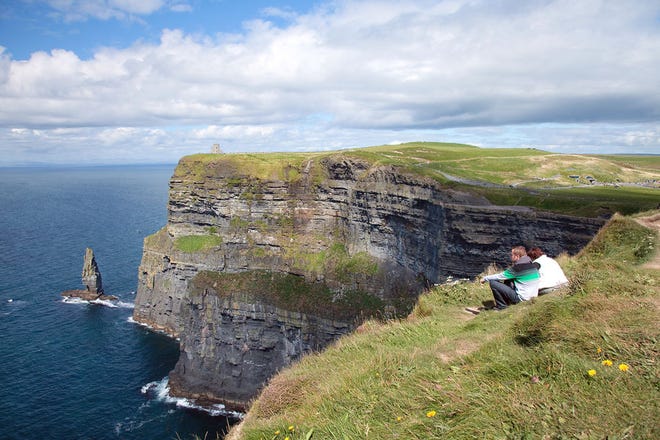
Popular stops around Ireland are coming up with creative ways to grapple with crowds. The Cliffs of Moher – the majestic sheer cliffs on Ireland's west coast – now cleverly offer half-price tickets (€4) online for visits before 11 am and after 4 pm. Smart travelers are wise to visit at these times not just because it's a little cheaper, but because lighter crowds make for a more tranquil experience at the cliffs. Tickets include parking and admission to the visitors center and its exhibit, which focuses on the cliffs' natural and geological history.
South of Dublin, in County Wicklow, Avondale House – the former residence of Irish political leader Charles Parnell – has closed for a long-term renovation. A reopening date has not yet been announced. In the southern port town of Kinsale, Desmond Castle is also closed to visitors for an indefinite period of time.
Residents of Northern Ireland are wrestling with the effects of an impending Brexit. But tourists aren't likely to experience any significant impacts: In 2020, I expect a visit to Northern Ireland to be just as easy as ever, and probably even more interesting.
Traveling to the UK post-Brexit? Here's what you need to know before you go
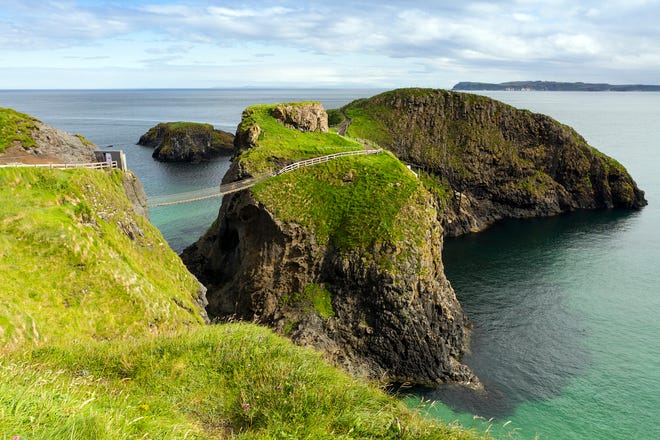
Planning is needed to visit a few popular sights near the town of Portrush, on the northern coast. To walk across Carrick-a-Rede rope bridge, dramatically suspended above the Antrim Coast, it's smart to buy timed-entry tickets ahead of your visit (now available online). To tour the Old Bushmills whiskey distillery, travelers should show up early, as groups are limited to 18 people and spots are only available on a first-come, first-served basis.
In Northern Ireland's capital of Belfast, the "Glider" buses, the city's new form of hybrid-powered rapid transit, have proved popular after a little more than a year of being fully up and running. These 105-person buses, connecting east and west Belfast on one line and the city center and Titanic Quarter on another, are particularly handy for travelers who want to get from the City Hall area out to the Titanic sights, including the excellent Titanic Belfast museum.
Although the series has ended, Game of Thrones lives on in Northern Ireland, where much of the show was filmed. In the town of Banbridge, 30 minutes from Belfast, a "Game of Thrones" studio tour – featuring actual sets, costumes, and props from the show – is slated to open later this year at Linen Mill Studios, one of the show's main production sites. Belfast itself celebrates its connection to the show with six free-standing stained-glass windows sprinkled around town. Each window represents a main house or family in the show (one for each episode of the final season).
Ireland is famously welcoming. But for the well-prepared traveler (who visits equipped with good information and the necessary reservations), that welcome will feel even warmer. May your guidebook be well used and the wind always at your back.
Source: Rick Steves
Special to USA TODAY
Friday, February 21, 2020
Alexander Calder Will Get A Prime Museum Site On The Benjamin Franklin Parkway In Philadelphia, Across From Barnes And Rodin
 |
| "Eagle," a 40 foot sculpture by Alexander Calder on loan to the Philadelphia Museum of Art in 1999 and 2000. |
A little more than two decades after a Calder museum was first proposed for the Benjamin Franklin Parkway, the long-dormant idea has blossomed again, funding has materialized, and backers say that, by spring 2021, construction should get underway between 21st and 22nd Streets across from the Barnes Foundation and the Rodin Museum.
Many details of the project, which would feature works by the endlessly inventive Alexander Calder, creator of the mobile, still have to be worked out, but supporters say they are committed for the long haul. Major funders include the Neubauer Family Foundation, the Pew Charitable Trusts, and the estate of H.F. “Gerry” Lenfest.
The works for display, which have not yet been selected, will be lent by the New York-based Calder Foundation for 99 years and would rotate through the Philadelphia facility, known informally as Calder Philadelphia. The art will be displayed in and around a building with a prominent garden.
Herzog & de Meuron, the Pritzker Prize-winning architects behind London’s Tate Modern, have signed on to the project, but no design renderings are yet available.
“We don’t know what we’re going to call it, but it’s not a museum,” said Alexander S.C. Rower, president of the Calder Foundation and grandson of the artist.
“This will involve a different way to engage art than what is usual with a museum,” he said. The idea, Rower said, is to create a more intimate experience for viewers and allow them to get closer to the artwork, free of the restrictions that normally dominate a museum setting.
“The experience is where the art happens,” he said. “This will not be a picture on a wall. This will be a place of introspection.”
He called the new structure and grounds a “sanctuary” as opposed to a museum.
1:18
The site of the planned Calder building and grounds near 21st and the Benjamin Franklin Parkway, in Philadelphia as shown by drone.
Joseph Neubauer, trustee of the Neubauer Family Foundation and one of the prime movers for the project, said that Calder’s sculptures, his stabiles and mobiles, would most likely be the defining feature of the facility and grounds.
“You need to be able to walk around it and experience” the sculpture, Neubauer said. “This is all about the individual experience with individual pieces of art.”
Rower said the building and grounds, located on the same two-acre site as the earlier, never-built Calder museum, are envisioned to encourage contemplation. The building will include galleries of some sort.
Neubauer said the size of the structure will be “modest, maybe 15-, 17-, 20,000 square feet, plus the garden."
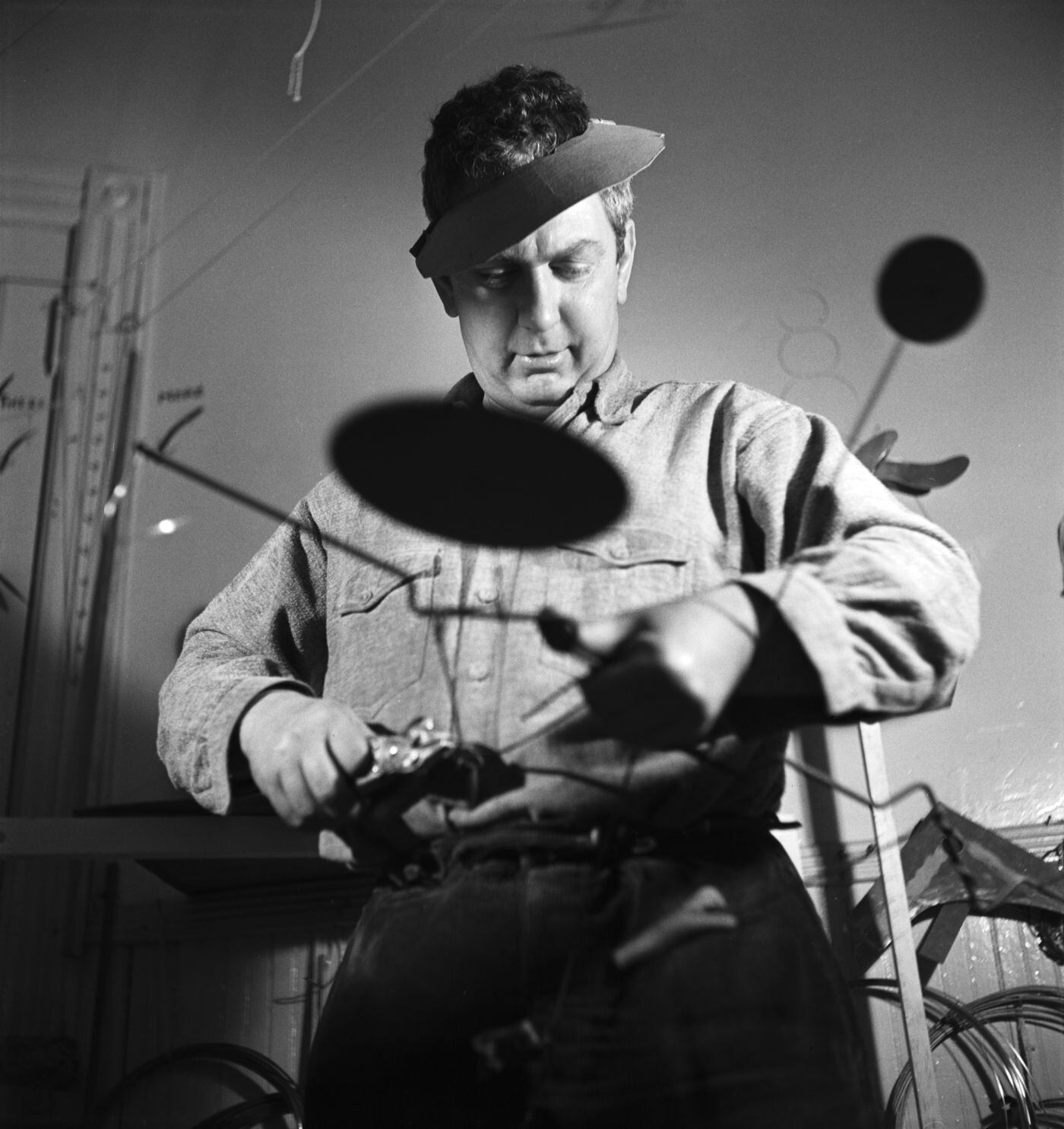
IMAGE BY HERBERT MATTER
Alexander Calder in his New York City storefront studio, 1936.
The site will be leased from the city and must go through normal approvals, including a City Council review and approval of the lease agreement. Terms of the agreement have not been set as yet. No city funding is involved in the project. (The site is open space, part of Fairmount Park. PennDot is currently using it as staging for the Vine Street and Chestnut Street reconstructions, but that use is temporary, city officials said.)
“Gardens are very important; you can’t assume they are just simple," Neubauer continued, discussing the configuration of the two-acre site. "This will be very welcoming to the public. We are going to try to activate the block for the public.”
The project, according to Neubauer, will cost about $50 million.
“Most of the money is coming from philanthropy,” he said, including funds from an anonymous donor along with the Neubauer, Pew, and Lenfest contributions. Additional support will come from the state.
The money is almost completely raised, he said, "We’re fairly close.”
Edward G. Rendell, former mayor and governor, who pushed for the initial museum back in 1999, said he found the revival of the idea “very gratifying.”
“There’s no doubt in my mind that Philadelphia is the only place for it,” he said. “Calder’s influence is felt all over the city, particularly in City Hall. This may be the final piece of the puzzle for the Parkway."
Diane Dalto Woosnam, who was Rendell’s deputy city representative for arts and culture and the city’s point person on the first Calder museum plan, said that she believed the site and the city have “always been perfect," adding: "But in true Philly fashion, it took 25 years for everyone to agree.”
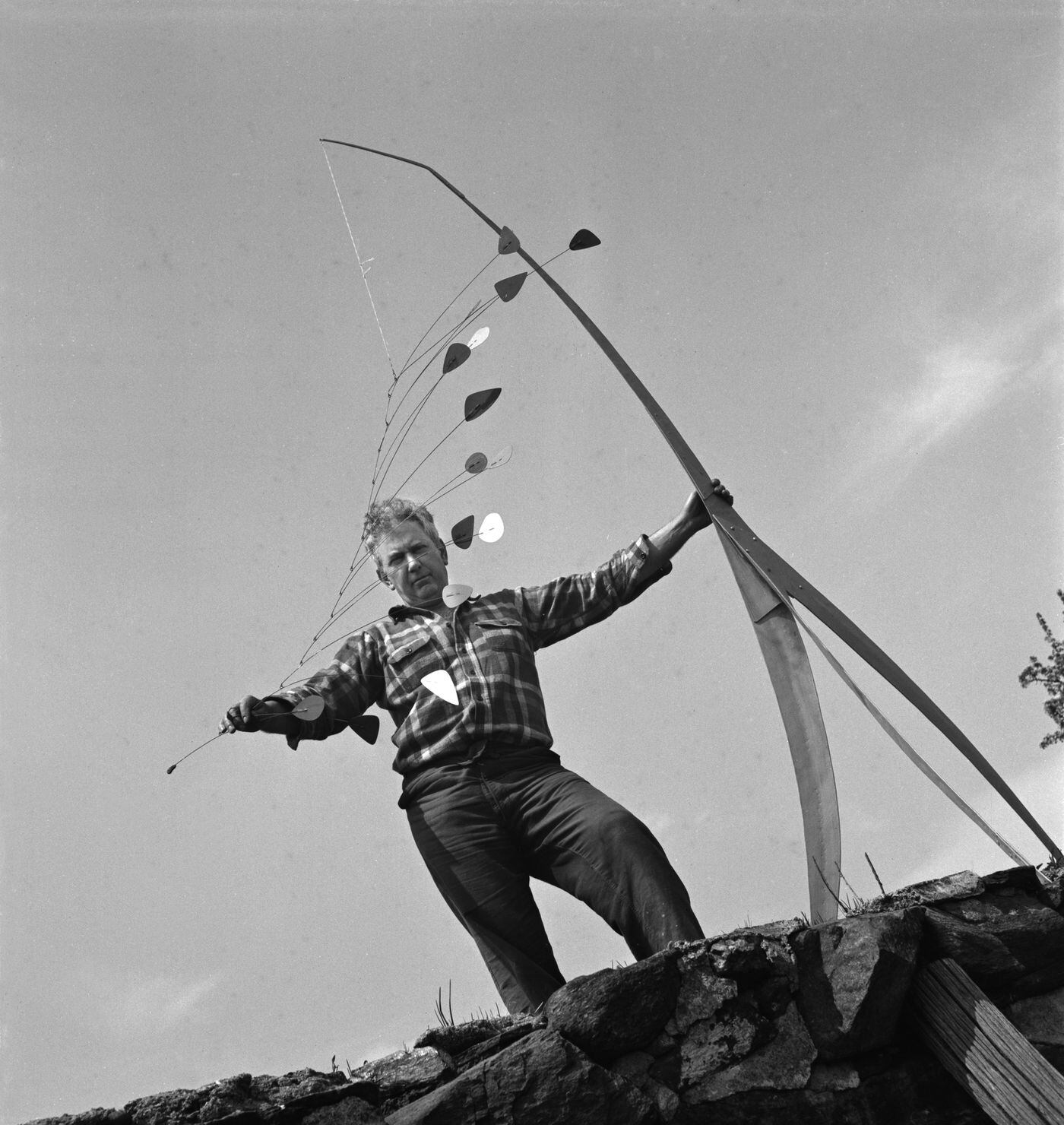
COURTESY CALDER FOUNDATION
Calder with Giraffe (1941), Roxbury, Conn., 1941. Image by Herbert Matter
The site of Calder Philadelphia underscores three generations of Calder family artwork along the Parkway as a defining factor on the Philadelphia cityscape. City Hall features the work of Calder’s grandfather Alexander Milne Calder, who created the major sculptures adorning the building, most prominently the statue of William Penn at the top.
Alexander Calder’s father, Alexander Stirling Calder, is famous for designing Swann Fountain on Logan Square a couple of blocks from what will be Calder Philadelphia. And one of Alexander Calder’s most intriguing mobiles, Ghost, hangs above the grand indoor entrance hall of the Philadelphia Museum of Art.
Works from Calder’s father and grandfather will also be featured in the new facility.
“This is a major accomplishment for Philadelphia,” said Rebecca W. Rimel, president and chief executive of the Pew Charitable Trusts. “The artistry of the Calder family is an important part of the fabric of our city. ... A home on the Parkway for some of Calder’s most consequential works will advance the city’s reputation as a world-class arts destination and enhance its appeal to national and international visitors.”
And there are other public works by Alexander Calder within shouting distance of the planned museum’s site.
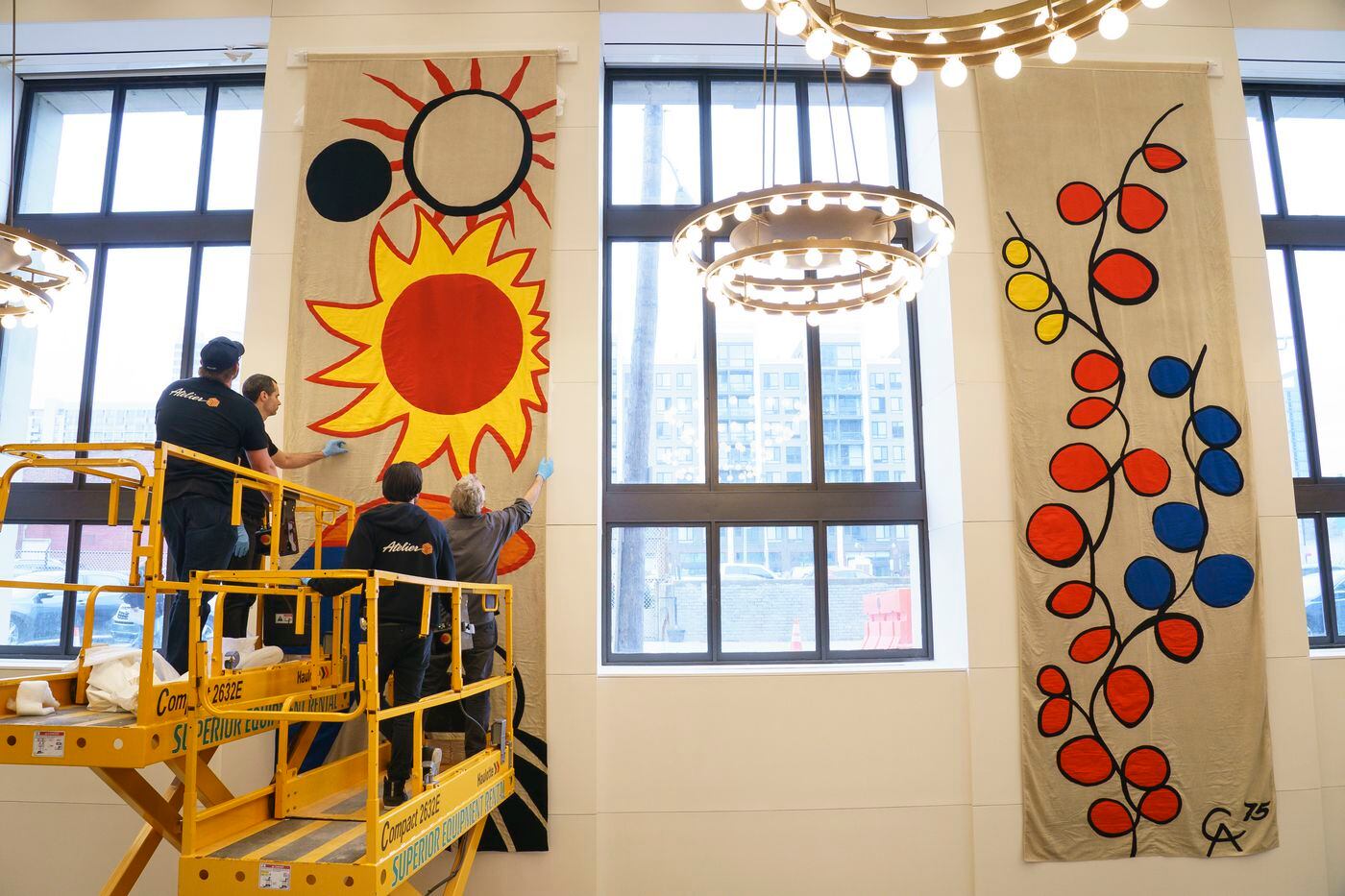
JESSICA GRIFFIN / STAFF PHOTOGRAPHER
Banners created by Alexander Calder in the 1970s, lost and out of view for most of the last 35 years, are installed at the Free Library of Philadelphia last month.
The Central Branch of the Free Library of Philadelphia, for instance, just began hanging eight newly conserved banners the artist designed in 1975 for Centre Square across from City Hall. The banners vanished when the atrium in the building was renovated in the 1980s. They were found in a storage closet about 15 years later and are now going up again in the library’s Heim Center for Cultural and Civic Engagement.
Mayor Jim Kenney described the Calder family’s work as being literally "woven into the fabric of the city for more than a century.”
Alexander Calder was born in 1898 in Lawnton, Dauphin County, and spent his childhood in Philadelphia. Most of his artwork was created in New York City, France, and in Connecticut. He died in 1976.
Calder Philadelphia will be an independent nonprofit with its own board of directors. Backers of the project said they are working out a collaborative relationship with the Barnes Foundation for select administrative, curatorial, educational, and operational services.
None of those details have been firmed up, yet.
The Calder Foundation’s Rower said selection of the artworks, the number of artworks, how they will be displayed, and other physical details await design renderings.
“How many? We don’t know,” he said. “Yet it will be exactly the right number for the design.”
“Our program is diagonally across from the Rodin,” he said. “The greatest sculptor of the 19th century and the greatest sculptor of the 20th century. That’s the dialogue
Subscribe to:
Comments (Atom)



